History of Saga
Naomasa Nabeshima, 10th lord of Saga Han
 Naomasa Nabeshima became the 10th lord of Saga Domain (han) at the age of 17. Demonstrating strong leadership, he was committed to the introduction of science and technology, administrative reform, and education.
Naomasa Nabeshima became the 10th lord of Saga Domain (han) at the age of 17. Demonstrating strong leadership, he was committed to the introduction of science and technology, administrative reform, and education.
Vaccination at Saga Castle
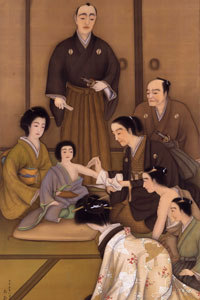 When smallpox was prevalent in Saga Han, Naomasa Nabeshima learned that a vaccination made of cowpox virus was effective to prevent the disease. He ordered his retainer to obtain the vaccine from the Netherlands and had his son Junichiro (Naohiro) inoculated with it. After that, the vaccination was introduced throughout Japan.
When smallpox was prevalent in Saga Han, Naomasa Nabeshima learned that a vaccination made of cowpox virus was effective to prevent the disease. He ordered his retainer to obtain the vaccine from the Netherlands and had his son Junichiro (Naohiro) inoculated with it. After that, the vaccination was introduced throughout Japan.
Manufacturing cannons
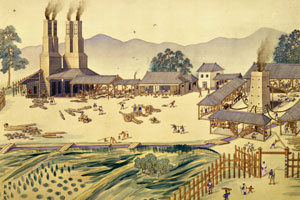 In Saga Han, Dutch technical books were translated to learn theories and mechanisms with a view to manufacturing cannons. The first reverberatory furnace in Japan was built in Saga. Competent artisans, including swordsmiths and casters, were invited to build it regardless of their social standing.
In Saga Han, Dutch technical books were translated to learn theories and mechanisms with a view to manufacturing cannons. The first reverberatory furnace in Japan was built in Saga. Competent artisans, including swordsmiths and casters, were invited to build it regardless of their social standing.
Defending Edo Bay
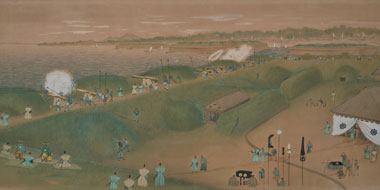 In 1853, a warship squadron commanded by Commodore Matthew Perry called at Uraga (present-day Yokosuka City, Kanagawa Prefecture). The shogunate decided to build a battery off the coast of present Shinagawa, Tokyo, to defend Edo Bay while continuing diplomatic negotiations. It placed an order for cannons for the battery with Saga Han, which boasted the most advanced technology of cannon manufacturing in those days.
In 1853, a warship squadron commanded by Commodore Matthew Perry called at Uraga (present-day Yokosuka City, Kanagawa Prefecture). The shogunate decided to build a battery off the coast of present Shinagawa, Tokyo, to defend Edo Bay while continuing diplomatic negotiations. It placed an order for cannons for the battery with Saga Han, which boasted the most advanced technology of cannon manufacturing in those days.
Railway development
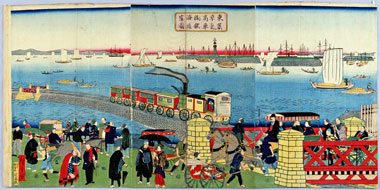 The greatest contributor to the development of railways in Japan is Shigenobu Okuma from Saga Han. He also served as Prime Minister twice and founded Waseda University
The greatest contributor to the development of railways in Japan is Shigenobu Okuma from Saga Han. He also served as Prime Minister twice and founded Waseda University
Personages
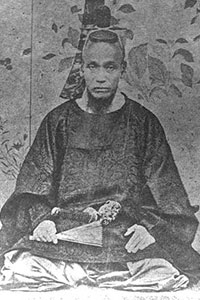
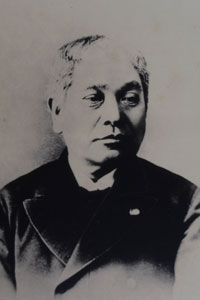 Japan in the 19th century was at a turning point from the Edo Period to the Meiji Era. During the Meiji Restoration, Japan's national politics underwent a dramatic change from a feudal system, under which samurai were dominant, to a modern government. Figures from Saga Han played active roles in many developments, such as the transfer of the capital to Tokyo, the opening of Hokkaido, the introduction of medical practices, and the establishment of judicial and educational systems.
Japan in the 19th century was at a turning point from the Edo Period to the Meiji Era. During the Meiji Restoration, Japan's national politics underwent a dramatic change from a feudal system, under which samurai were dominant, to a modern government. Figures from Saga Han played active roles in many developments, such as the transfer of the capital to Tokyo, the opening of Hokkaido, the introduction of medical practices, and the establishment of judicial and educational systems.
What is the Edo Period?
The Edo Period refers to a period lasting about 260 years. Beginning in 1603, when Ieyasu Tokugawa became "shogun," the commander-in chief who established the "shogunate" in Edo (present-day Tokyo), it lasted until the fall of the shogunate in 1868. During that time, the Shogun controlled the "daimyo," the lords of local domains. One of the most effective ways of controlling them was through the "sankin-kotai" (alternate-year attendance) system, which mandated that daimyo have residences around the Edo Castle, have their families live there as hostages, and pay a courtesy visit to the shogun on a regular basis. The shogunate also banned Christianity and limited trading partners to the Netherlands, China, Korea and Ryukyu (present-day Okinawa). Building a seclusive and tightly regulated society resulted in a 260-year-long peaceful period and the development of a unique society and culture.
What is Saga Han?
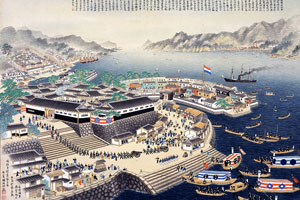 "Han" is a general term referring to a domain ruled by a local lord, called the daimyo, and his ruling system. It existed until 1871 when a prefectural system was established after the Meiji Restoration. Saga Han was the 8th largest, excluding those governed by Tokugawa family members, of about 250 hans in Japan. It was ruled by the Nabeshima Family (beginning with Naoshige, the first lord, and his son Katsushige through to Naohiro, the 11th lord), and its domain included part of present-day Nagasaki Prefecture. From 1642, Saga Han was ordered by the shogunate to guard Nagasaki Port, which was the only window open to the outside world, namely the Netherlands and China. It was therefore in a position to be better informed of overseas situations, and as a result it introduced science and technology before any other han at the end of the Edo Period.
"Han" is a general term referring to a domain ruled by a local lord, called the daimyo, and his ruling system. It existed until 1871 when a prefectural system was established after the Meiji Restoration. Saga Han was the 8th largest, excluding those governed by Tokugawa family members, of about 250 hans in Japan. It was ruled by the Nabeshima Family (beginning with Naoshige, the first lord, and his son Katsushige through to Naohiro, the 11th lord), and its domain included part of present-day Nagasaki Prefecture. From 1642, Saga Han was ordered by the shogunate to guard Nagasaki Port, which was the only window open to the outside world, namely the Netherlands and China. It was therefore in a position to be better informed of overseas situations, and as a result it introduced science and technology before any other han at the end of the Edo Period.

